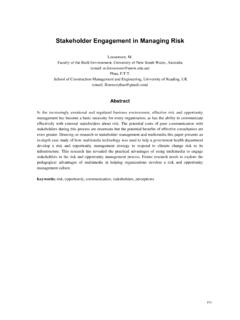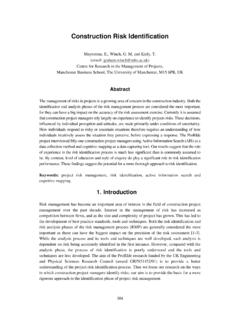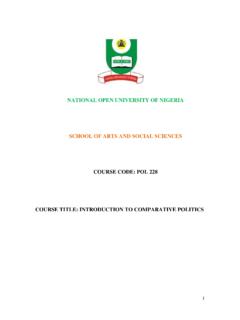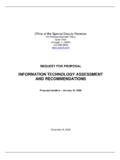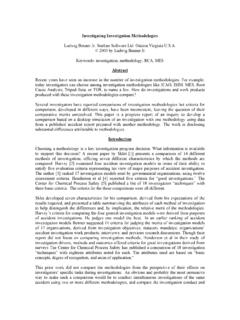Transcription of Public Sector Comparator (PSC): A Value for Money …
1 Public Sector Comparator (PSC): A Value for Money (VFM) assessment Instrument for Public private partnership (PPP) Ismail. K. Universiti Teknologi MARA (UiTM), Malaysia (email: Takim, R. Universiti Teknologi MARA (UiTM), Malaysia (email: Nawawi, A. H. Universiti Teknologi MARA (UiTM), Malaysia (email: Egbu, C. School of the Built Environment, University of Salford, M5 4WT England, UK (email: Abstract Economy, efficiency and effectiveness of service provisions known as Value for Money (VFM) have been the main catalyst for Public private partnership (PPP) procurement. VFM can be achieved through the evaluation of quantitative and qualitative aspects of projects. The method commonly used in the assessment of VFM for PPP project is the Public Sector Comparator (PSC) which is the key management tool in the quantitative assessment of VFM.))))
2 However, this method had been criticised on numerous grounds such as: lack of accuracy of risk transfer; discount rate methodology; complexity of financial modeling; assumptions underlying and limitation scope of qualitative and intangible aspects in the PSC calculations. Using the information derived from the review of PSC models from Hong Kong, South Africa, Ireland and Australia, important elements are captured. These are: components of PSC; the developing of PSC, PSC assessment stages and development of PSC criteria. In this respects, the study suggests that in order to produce a robust PSC model across project phases (strategy formulation, procurement stage, construction stage and operation stage), the assessment of PSC for VFM is to embrace both the qualitative (non financial) and quantitative (financial) aspects.
3 Considering these elements, a further empirical research is needed for validation of findings. Keywords: Public Sector Comparator , Value for Money and Public private partnership 1721. Introduction The need for infrastructure development to provide better services for Public entities requires the use of an alternative method for procuring project and financing strategies. The introduction of partnership arrangements for the provision of infrastructure could be one of the alternative options for government to procure Public projects. In this regard, Public private partnership (PPP) is an increasingly popular infrastructure development model with government in many provinces and countries. Between 2000 and 2007, many governments across the globe used PPPs to deliver some of the world s most important infrastructure (Raisbeck, 2009).
4 PPPs refer to the private Sector designing, building, maintaining, operating and financing infrastructure assets traditionally provided by the Public Sector (William, 2005). Public private partnership brings a single private Sector entity to undertake and provide Public infrastructure assets for their whole-of-life , generally 20-30 years. PPPs and other similar types of Public / private finance projects have proven their usefulness as may be seen in the examples of countries with the most experience, such as the United Kingdom, Ireland, the Netherlands, the Scandinavian countries, Portugal, Spain, France, Canada, Australia, New Zealand, Japan, Chile or Republic of South Africa. Nevertheless, the objective of PPP is not only to be an alternative for financing but also to combine Public and private Sector efforts in enhancing innovation, business spirit and effectiveness in delivery of Public services (Demirag et al.)
5 2004). This concept is well known as Value for Money (VFM) which means that the whole investment project life has to be realised at lower cost and optimum output and in line with the opinions of Victorian partnership (2008) and Cheung et al (2009). In PPP projects, VFM refers to the best available outcome through a comparative analysis of all benefits, costs and risks over the whole life of the procurement. The notion of Value for Money (VFM) is associated with the concepts of three Es: economy, efficiency and effectiveness which refer to the whole life Value of service provided. According to Demirag et al. (2004), economy is acquiring resources of an appropriate quality for the minimum cost. While, efficiency is about ensuring that maximum output is obtained from a given amount of resources and effectiveness regards to the desired results of the output.
6 The achievement of a VFM outcome is a crucial concept throughout the procurement process in all aspects of the project. Assessing the Value of these variables requires a degree of judgment and the use of both quantitative and qualitative analysis. VFM assessment is a continuous process across the following project phases: programme level, project level, procurement and project construction phase in order to achieve project effectiveness (Takim et al. 2009). VFM involves the process of developing and comparing costs between PPP project, traditional project delivery and bid price of private Sector , which relies on discount rate and Value of risk transfer (Murray, 2006 and Ontario, 2007). Many researchers are of the view that VFM is achieved through the savings resulting from the integration of synergies between designs, build and service operation throughout the procurement process.
7 173 Therefore, based on the above definitions, VFM is not the lowest cost option but an understanding of the whole life benefits and appropriate risk allocation between Public and private sectors. It is usually associated with utilizing innovative capabilities and skills, efficiency savings and best possible risk transfer to private Sector . There are many techniques in quantifying the VFM in PPP projects. For example, there are four main alternative approaches to provide the core test of VFM by researchers (Grimsey and Lewis, 2005). These are full cost benefit analysis, PSC-PPP comparison, UK style PSC PPP, and competitive bidding (Sach et al. 2005). Nevertheless, PSC is one of the most popular techniques in assessing VFM which has been adopted by many countries such as Australia, United Kingdom, Hong Kong, Japan, and Canada.
8 This is in line with the Malaysian PPP, which highlighted that PSC will play an important role as a benchmark to ensure that the government gets Value for Money (Ninth Malaysia Plan, 2006). The Public Sector Comparator (PSC) is the technical construct developed to test whether privately financed arrangements provide superior VFM to traditional bundled procurement methods. English & Guthrie (2003), describe PSC as an estimated reference project to provide the same level and quality of service expected of the private Sector alternatives. It requires assessment of net present costs and risks over the life of the project. Public Sector Comparator (PSC) has been the most common tool used by the Public Sector to show how much it would cost the government to build the asset through Public funding.
9 Nevertheless, the PSC method has come under growing criticism and debate about their reliability and accuracy of calculation as the method is prone to errors because of the complexity of its financial modeling (Grimsey & Lewis, 2005). The arguments against the use of the PSC method also questioned the appropriateness of this method to evaluate VFM due to its ambiguity and complexity problems. The ambiguity within this technique involved forecasting future cash flow, underlying assumption and choosing an appropriate discount rate in the PSC calculation ( Khadaroo, 2007). However, although this method had emerged with many weaknesses, it is still being accepted and widely applied in most countries. Hence, this paper provides an overview of PSC practices across the globe, focusing particularly on the practice of four countries: Hong Kong, South Africa, Ireland and Australia.
10 The key issues of these models are to enlighten the core components of PSC, the development of PSC instrument, PSC assessment stages and development of PSC criteria that are needed to make a comprehensive assessment for VFM in the PPP projects. From the analysis point of view, this method is mainly focused on the quantitative approach. Furthermore, it is also noted that there is lack of consideration on long - term evaluation in the VFM assessment process as practiced by most countries. It is vital that a complete VFM assessment requires consideration of qualitative factors and long term evaluation in conjunction with the quantitative assessment . Therefore, this study aims to review on primary issue of the concept of PSC as a VFM tool for PPP project undertaken by Hong Kong, South Africa, Ireland and Australia.



